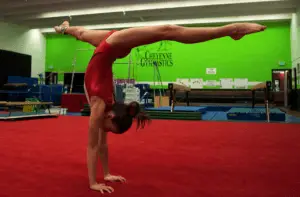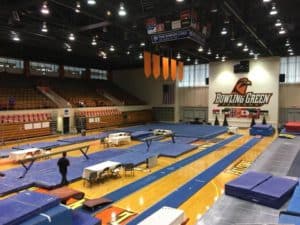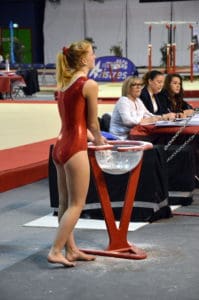So, your daughter was selected to join the gymnastics team? Congratulations and welcome to the world of competitive gymnastics!
Now, you probably have a LOT of questions. What does being on a gymnastics team involve? What will gymnastics competitions be like? Here are answers to many common questions asked by new gymnastics parents. I’ll also discuss the different levels at which your gymnast might compete.
What type of commitment will competitive gymnastics require?
Time Commitment

It depends on the team, but competitive gymnasts generally practice 2-6 days per week, with the higher levels practicing more hours. Practices generally run from 2-4 hours in length, and again, the higher levels will practice for a longer duration. As a new gymnast on the team, your child will likely practice 6-12 hours per week.
During the season, there will be meets on the weekends. Your gym will give you the meet schedule as the beginning of the season draws near.
Financial Commitment
You can expect a larger financial commitment on the gymnastics team compared to gymnastics classes. In addition to increased monthly fees for increased hours of training, you’ll have competition fees, booster club fees, the cost of leotards, warm-ups, and other apparel, along with travel fees if the competitions will be out of town. Some gymnastics clubs offer fundraising opportunities to help defray costs, so be sure to check those out if the extra costs are intimidating!
Will gymnastics team practice be similar to gymnastics classes?
The short answer is, yes and no.
On the team, your gymnast may practice some of the same skills she has learned previously in her classes. However, once a gymnast makes the team, the focus becomes learning basics, body shapes, strength, and flexibility. The coaches want to prepare the new team gymnasts for the skills they will be competing now, as well as in the future. Taking the time to learn skills correctly the first time will make it much easier to learn difficult skills down the road.

You’ll also notice a difference between gymnastics practices during the off-season, compared to in-season training. During the season, the focus is on perfecting the skills and routines that the gymnast is currently competing. They may not work on up-level skills very much during the gymnastics season. Once the championship meets are completed, though, that’s the time to start training skills for the higher levels. Coaches may have more flexibility in their assignments, and gymnasts can have the opportunity to play around with new skills and maybe even get a little creative!
You can expect your gymnast to have practice year-round. Taking breaks can make it difficult to maintain the proper level of conditioning. For this reason, most gyms take minimal breaks during the year.
What will my gymnast need for competition?

The gym will order team leotards and warm-up suits. Team families are generally responsible for the cost of these items. The gym may order team gym bags, but if they do not, your gymnast will want one to store her things while she competes. Here’s a fun one with plenty of space to store all of your gymnast’s things.
Your coach will let you know when your gymnast needs to start wearing handgrips for the bars. If you’re looking for a pair of grips, check out the Guide to Gymnastics Grips. Even if your gymnast does not wear grips yet, she may want a roll of tape and prewrap in her bag in case she gets a rip. Band-aids always come in handy, too!
Scrunchies – usually the team will have uniform scrunchies or hair bows, but in case you’re in need of something special, you can find it here. It’s always a good idea to keep some extra hair bands and hairspray in the competition bag.

Water bottle – if your gymnast gets thirsty during the competition, it might be a hike to get to a water fountain! Plan ahead and bring a reusable water bottle.
Hand sanitizer/wipes – so your gymnast can stay healthy all season!
What can I expect at a gymnastics competition?

When you get to the competition site, your gymnast will check in and receive a competition number. From this point on, she will go with her coach, and parents will sit in the stands to watch.
Competitions always start with a 15-30 minute general stretch period. During this period, gymnasts perform warm-up activities, stretching, and sometimes a few basic tumbling skills.
What happens next will depend on the competition format. There are several acceptable competition formats, but they all include timed warm-ups on each event, followed by competition. Competition might take place several minutes or even a couple of hours after your gymnast warms up! The coaches will make sure that the gymnasts stay warm and ready for their next competitive event.
Regardless of the type of competition, gymnasts always warm up and compete in Olympic order. Olympic order is vault, bars, beam, and floor. This means that if a gymnast starts on beam, she’ll compete on floor next, then vault, and finish on bars.
Gymnasts of all different ages can compete in the same level, but they will be divided into age groups for awards purposes. The awards ceremony is held immediately following the meet. A percentage of gymnasts on each event will receive awards. Awards are also given for the all-around (all four scores added together), and some meets will have team awards as well.
What will the competition schedule look like?
Your gym will tell you how many meets your team will compete in. In some areas, there is a fall season and a spring season. In other areas, there is only one gymnastics competition season. In the case of a fall and spring season, the fall season typically goes from September-December. The spring season runs from January-March/April. In areas where there is only one season, it usually starts in December/January and extends through March/April.
Meets are generally held on weekends, but some large invitationals extend their meets to Fridays, and occasionally even a Thursday! I’ve also seen meets held on holiday Mondays, such as Martin Luther King, Jr. Day.
The earliest time a competition can start is 8:00am, and the latest it is allowed to finish is 10:00pm.
Some gyms choose to do meets that are close to home, and other gyms like to travel to out of state meets. Your gym will give you more details about how much travel will be required for gymnastics competitions.
At the end of the season, there will often be a championship meet, such as a state meet. See below for more details about which championship meets are available for different levels.

Competitive Gymnastics Organizations
There are several organizations that conduct gymnastics competitions. The largest of these governing bodies are: USAG, AAU, and NGA. I’ll go over the level structure for each of these organizations below.
Some areas also have organized competitions hosted by YMCA’s, local parks or recreation departments, or other smaller organizations. The competition structure for these organizations varies by geographical location.
Overview of Competitive Gymnastics Levels
USAG Level Framework
USA Gymnastics (USAG) offers two types of competitive gymnastics programs: Development Program (Dev) and Xcel Program.
Dev Compulsory Levels
The USAG Development Program (Dev) level system consists of 10 levels. Levels 1-5 are compulsory levels, which means that all of the gymnasts in that level perform the same routines. Each level gets progressively harder, and the skills in the levels are designed to build on one another.
For a look at the compulsory skills, check out the 2021-2029 Compulsory Skills.
Compulsory competition finishes with a state meet at the end of the season. The state meet is usually held in March or April.
Dev Optional Levels
Levels 6-10 in the USAG Dev program are the optional levels. In the optional levels, coaches and gymnasts can develop their own routines by choosing which skills best fit the gymnast’s skill set and meet the level’s Special Requirements.
Levels 6 and 7 are beginning optional levels. In these levels, there are difficulty restrictions, and the focus is on performing basic optional skills with good technique. There is no benefit to performing difficulty above the gymnast’s level, and in some cases, it can even be a deduction!
Level 8 is an intermediate optional level. In Level 8, gymnasts still have difficulty restrictions, but there is a wider range of allowable skills which meet the requirements. At Level 8, the Start Value is 10.0 if all of the Special Requirements are met.
Level 9 and 10 are advanced optional levels, which require bonus skills or connections to achieve a 10.0 Start Value. At Level 9, the base Start Value is 9.7, and gymnasts must earn bonus points to start at a 10.0. At Level 10, the base Start Value is 9.5, and gymnasts must earn 0.5 in bonus to start at a 10.0.
All optional levels have the opportunity to qualify to a regional meet from their state meet. Levels 9 and 10 can qualify to a national meet from the regional meet.
Here’s a look at some articles about optional gymnastics.
Xcel Levels
The Xcel program is also part of USAG, but it has a completely separate level framework from the Level 1-10 system. There are five Divisions in the Xcel program: Bronze, Silver, Gold, Platinum, and Diamond. Click on each division for an overview of its requirements.
The Xcel program was designed to keep gymnasts involved in the sport, even if they don’t want to train as many hours as a Dev gymnast. All of the routines are optional routines, so the gymnasts get to construct their routines within the requirements for the division. The requirements are easier than Dev optionals.
Xcel gymnasts have a state meet at the end of the season, and Silver, Gold, Platinum, and Diamond gymnasts have the opportunity to qualify to a regional meet from the state meet.
If you’d like to look at the requirements for Xcel gymnastics, here they are broken down by division: Bronze, Silver, Gold, Platinum, and Diamond.
AAU Level Framework
The AAU program follows USAG’s level structure and rules, with some modifications as listed in the AAU Rules Documents. The program includes compulsory levels, Xcel levels, and optional levels up through Level 9. Level 9 is called Open Optional in the AAU program, and athletes are allowed to perform all difficulty and earn connective and difficulty bonus in this level.
AAU has four different regions which hold their own regional championships, followed by a national championship in the summer. All levels are eligible for these championship meets.
NGA Level Framework
The National Gymnastics Association (NGA) has its own level system, which has a total of 13 levels. Their level structure consists of Levels 1-10, plus Gold (between Levels 4&5), Platinum (between Levels 6&7), and Diamond (between Levels 8&9). Each level has optional requirements, even at the lowest levels. Levels 9 and 10 require bonus in order to obtain a 10.0 Start Value, just like they do in the USAG program.
NGA has a national championship meet for all levels. In 2022, gymnasts can qualify from either an in-person state meet or a virtual regional meet.

Miscellaneous Competitive Gymnastics Info
Gymnastics meets are a lot of fun for the gymnasts, but they can be long! Plan to be there for around 4 hours, including the awards ceremony.
Most big meets will have vendors selling leotards and other keepsakes. Sometimes there will be a photographer, and you can purchase professional photos of your gymnast in action.
Not all gymnasts will receive an award on each event. Especially when your gymnast is just starting to compete, you’ll want to prepare her that she may not receive an award.
Finally, enjoy the ride! Sometimes your gymnast will have a great meet, and other times not so much. Be supportive of her no matter what happens, and make sure she knows how incredible she is -whether she stuck everything, or if she fell off the beam five times. Gymnastics is a marathon, not a sprint, so buckle up and enjoy!!!
